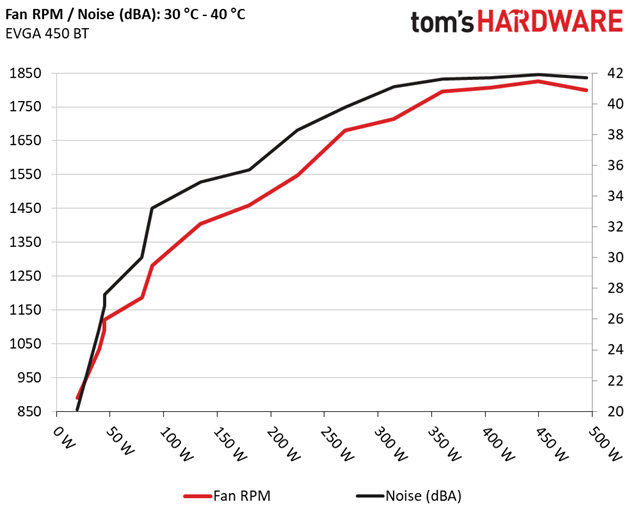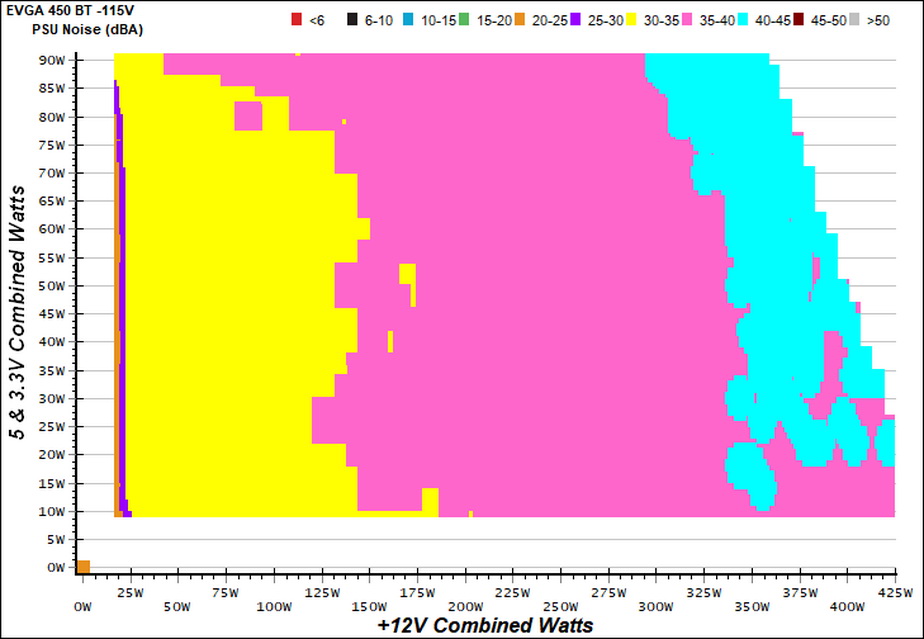EVGA 450 BT PSU Review: Amazing Value At $25
Why you can trust Tom's Hardware
Efficiency, Temperature & Noise
Efficiency
Our efficiency testing procedure is detailed here.
Using results from the previous page, we plotted a chart showing the 450 BT’s efficiency at low loads, and loads from 10 to 110 percent of its maximum-rated capacity.

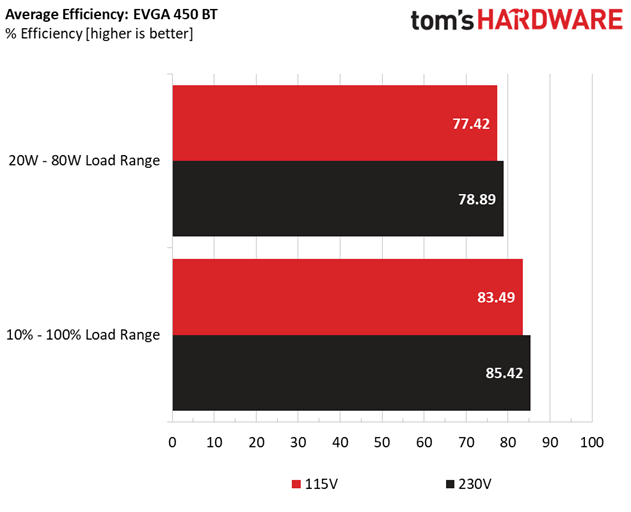
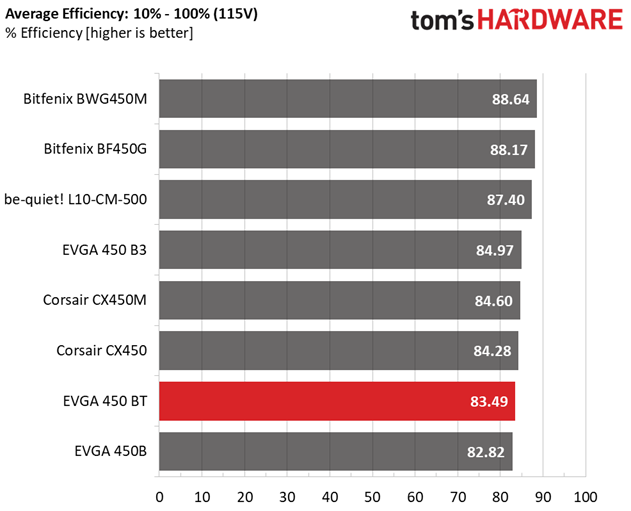

The majority of PSUs with a similar capacity and 80 PLUS rating achieved higher efficiency under normal loads. But under light loads, the 450 BT took the lead from Corsair's CX and CXM models.
Efficiency At Low Loads
In the following tests, we measured the PSU's efficiency at loads significantly lower than 10 percent of its maximum capacity (the lowest load the 80 PLUS standard measures). The loads we dialed were 20, 40, 60, and 80W. This is important for representing when a PC is idle, with power-saving features turned on.
| Test # | 12V | 5V | 3.3V | 5VSB | DC/AC (Watts) | Efficiency | Fan Speed | PSU Noise | PF/AC Volts |
|---|---|---|---|---|---|---|---|---|---|
| 1 | 1.212A | 0.486A | 0.477A | 0.194A | 19.448 | 68.090% | 890 RPM | 20.1 dB(A) | 0.505 |
| 11.853V | 5.123V | 3.339V | 5.152V | 28.562 | 115.34V | ||||
| 2 | 2.490A | 0.978A | 0.987A | 0.389A | 39.879 | 77.464% | 1034 RPM | 25.3 dB(A) | 0.653 |
| 11.883V | 5.107V | 3.338V | 5.145V | 51.481 | 115.32V | ||||
| 3 | 3.695A | 1.470A | 1.467A | 5.138A | 59.347 | 81.125% | 1120 RPM | 27.6 dB(A) | 0.742 |
| 11.896V | 5.099V | 3.337V | 5.138V | 73.155 | 115.30V | ||||
| 4 | 4.974A | 1.963A | 1.975A | 0.780A | 79.803 | 82.994% | 1186 RPM | 30.0 dB(A) | 0.796 |
| 11.904V | 5.094V | 3.337V | 5.131V | 96.155 | 115.27V |
Under light loads, the 450 BT achieved satisfactory efficiency levels given its low price. The PSU's fan spun at high speeds though, mostly because the operating temperatures during those tests were above 30°C.
5VSB Efficiency
The ATX specification, along with CEC, ErP Lot 3 2014 and ErP Lot 6 2010/2013, states that 5VSB standby supply efficiency should be as high as possible, recommending 75 percent or higher with 550mA, 1A, and 1.5A of load. The PSU should also achieve higher than 75% efficiency at 5VSB under full load, or with 3A if its max current output on this rail is higher than 3A.
We take six measurements: one each at 100, 250, 550, 1000, and 1500mA, and one with the full load the 5VSB rail can handle.
Get Tom's Hardware's best news and in-depth reviews, straight to your inbox.
| Test # | 5VSB | DC/AC (Watts) | Efficiency | PF/AC Volts |
|---|---|---|---|---|
| 1 | 0.100A | 0.516 | 75.328% | 0.038 |
| 5.151V | 0.685 | 115.38V | ||
| 2 | 0.250A | 1.287 | 78.571% | 0.090 |
| 5.147V | 1.638 | 115.38V | ||
| 3 | 0.550A | 2.827 | 79.589% | 0.181 |
| 5.138V | 3.552 | 115.37V | ||
| 4 | 1.000A | 5.125 | 79.680% | 0.282 |
| 5.123V | 6.432 | 115.37V | ||
| 5 | 1.500A | 7.662 | 78.860% | 0.356 |
| 5.107V | 9.716 | 115.38V | ||
| 6 | 2.501A | 12.685 | 74.993% | 0.438 |
| 5.072V | 16.915 | 115.36V |

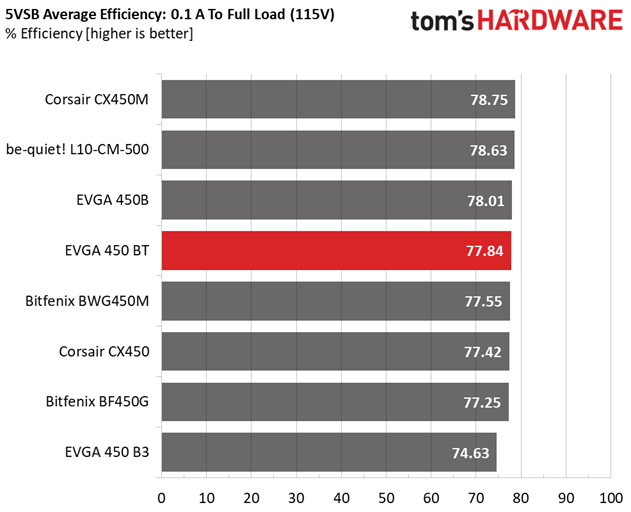
The 5VSB rail achieved high efficiency levels. We've seen much more expensive power supplies fare worse in these tests.
Power Consumption In Idle And Standby
In the table below, you'll find the power consumption and voltage values of all rails (except -12V) when the PSU is idle (powered on, but without any load on its rails), and the power consumption when the PSU is in standby mode (without any load, at 5VSB).
| Mode | 12V | 5V | 3.3V | 5VSB | Watts | PF/AC Volts |
|---|---|---|---|---|---|---|
| Idle | 11.900V | 5.104V | 3.379V | 5.157V | 4.786 | 0.411 |
| 115.3V | ||||||
| Standby | 0.045 | 0.003 | ||||
| 115.3V |
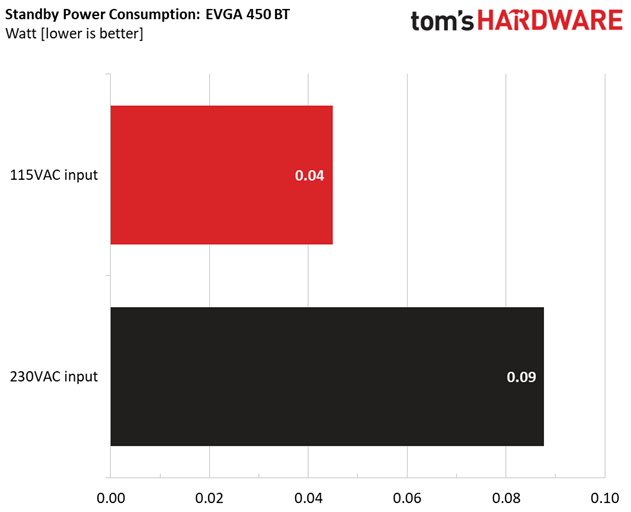
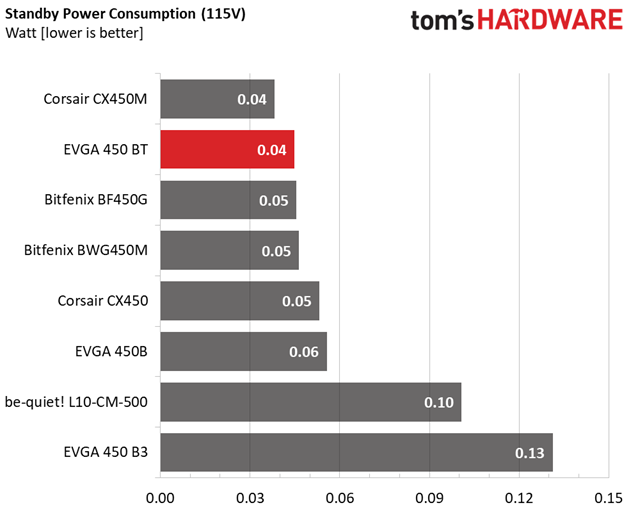
Vampire power remained low in both test cases.
Fan RPM, Delta Temperature, And Output Noise
Our mixed noise testing is described in detail here.
The first chart below illustrates the cooling fan's speed (in RPM), and the delta between input and output temperature. The results were obtained at 30°C (86°F) to 40°C (104°F) ambient temperature.
The next chart shows the cooling fan's speed (again, in RPM) and output noise. We measured acoustics from one meter away, inside a hemi-anechoic chamber. Background noise inside the chamber was below 6 dB(A) during testing (it's actually much lower, but our sound meter’s microphone hits its floor), and the results were obtained with the PSU operating at 30°C (86°F) to 40°C (104°F) ambient temperature.
The following graph illustrates the fan's output noise over the PSU's operating range. The same conditions of the above graph apply to our measurements, though the ambient temperature was between 30°C (86°F) to 32°C (89.6°F).
Even with minimal load, the fan generated more than 30 dB(A). Its profile could be less aggressive under light and moderate loads, but apparently RSY wanted to stay on the safe side.
MORE: Best Power Supplies
MORE: How We Test Power Supplies
MORE: All Power Supply Content
Current page: Efficiency, Temperature & Noise
Prev Page Load Regulation, Hold-Up Time & Inrush Current Next Page Protection Features
Aris Mpitziopoulos is a contributing editor at Tom's Hardware, covering PSUs.
-
Onus This looks like a decent choice for a business-class PC, or even a light gamer, which probably won't pull more than half its rated output.Reply -
chimera201 Could you measure hold up at lower loads(20%, 50%, etc)?Reply
And why isn't inrush results included in cybenetics database?
Normally "S" is considered higher than "A++" -
Aris_Mp S stands for standard. As for the hold-up time, it is measured only in the worst case scenario, which is full load. Unfortunately there is no time to take extra measurements, especially since we want to implement some other tests.Reply
About the inrush current, Cyben''s pdf report covers only the basic in order to be kept at a normal size. -
chimera201 Just curious how the values for hold up would look like at lower loads (I know it's higher). If you do plan on testing it even once at-least do it on a cheaper PSU unit. Testing it on a higher-end unit would defeat the purpose.Reply
And I thought Cybenetics was supposed to give a detailed report. Not including inrush results, etc kind of defeats the purpose. -
Aris_Mp The main role of Cybenetics is to provide efficiency and noise certifications. The extra results are just to let people know a little more about a PSU's quality. If Cyben provided everything then it would be a review and not a certification.Reply -
HERETIC-1 Quality,low power PSU's are hard to find-Reason-Quality components cost money.Reply
PSU IS THE MOST IMPORTANT PART OF ANY BUILD.....................
RECOMENDED-
Seasonic G360 or G450
Corsair SF450 -
Marlin Schwanke Read the list of cons again. This thing is junk. There is no such thing as a decent $25 power supply.Reply -
fry178 so more cons than pros, calling it decent build quality when almost all cons are related to quality.Reply
lol.
less respect with every review like this.. -
Aris_Mp Every product is judged based on its price.Reply
"Almost all cons are related to quality". Actually two our of the six have to do, in a degree, with build quality. Thin cables and overated MOV. Transient response, lower hold-up time, noise and old platform are not build quality related. Build quality has to do with the quality of the components and the craftsmanship unless you imply/understand something else.
You know what I also call decent build quality? A PSU that has a 25C rating and manages to finish all of my tests at much higher ambient temperatures. If its components were crappy then it wouldn't even last a minute under the overload tests, as many other PSUs that have died in my hands so far. -
fry178 cables are still components.Reply
and as well as everything else, it's still directly/indirectly related to quality, no matter if physical parts or design/engineering.
especially since this isnt a box sold by a 12y living in the grandparents basement.
i dont expect a semi modular unit with a 140mm silent fan on this, but i doubt lots of ppl would consider this type of "quality" product, if it was anything else they are using, not even talking about the fact its a name brand that sells very good units.
when did it start to be ok for a product to have more cons than pros?...
doesnt make any sense to me to call it "amazing value".
but i guess thats just me.

